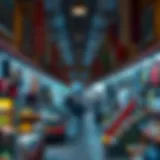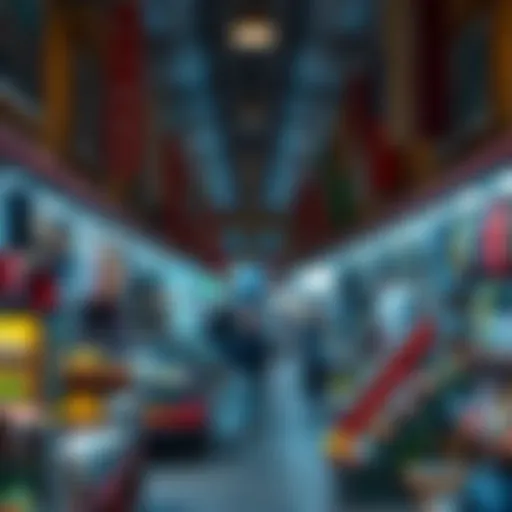Discovering Al Fahidi Historical Neighborhood: Dubai's Heritage
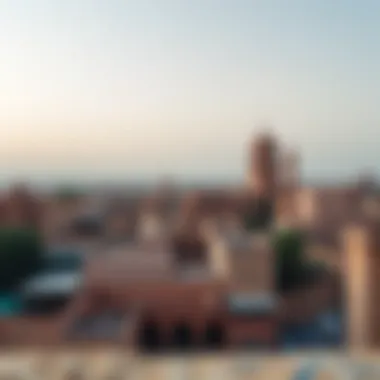
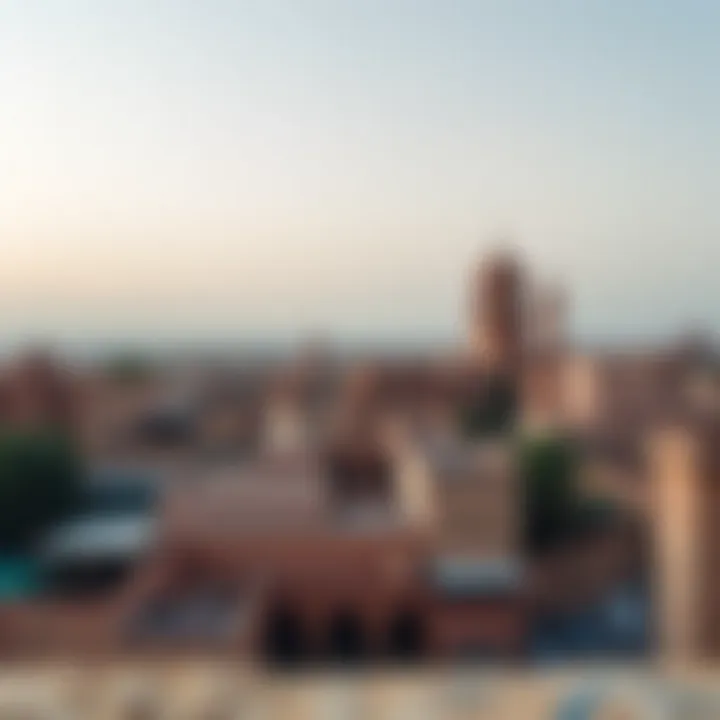
Intro
Al Fahidi Historical Neighborhood, once known as Al Bastakiya, holds a special place in Dubai's storied narrative. This area isn't just a piece of history; it's the embodiment of a cultural identity that has evolved through time, mirroring the emirate's transition from a modest trading port to a towering metropolis. Its winding alleyways, traditional wind-tower architecture, and vibrant arts scene invite a deeper connection with Dubai’s past.
Walking through this neighborhood is like flipping through the pages of an intricate history book filled with tales of trade, migration, and community. It stands as a vibrant reminder of what Dubai once was, and in many ways, still is—a melting pot of cultures and a testament to the resilience and ingenuity of its people.
In this exploration, we will peel back the layers of Al Fahidi’s architectural gems and the stories they hold, while providing valuable insights for investors, buyers, and expatriates looking to connect with the heritage of this unique locale.
Intro to Al Fahidi Historical Neighborhood
Al Fahidi Historical Neighborhood, also known as Al Bastakiya, carries an essence like no other tucked away in the bustling modernity of Dubai. This area is not just a collection of buildings; it reflects a vital chapter of the emirate's rich history and cultural heritage. Understanding Al Fahidi is akin to peering through a time-worn lens that reveals the roots of a city that has transformed from a small trading port into a global powerhouse. Visitors and locals alike find themselves captivated by its labyrinth of narrow alleyways, artful architecture, and an atmosphere that whispers stories from the past.
Historical Context
Established in the late 19th century, Al Fahidi served as a vibrant hub for Persian merchants, many of whom built their homes here. The architecture harkens back to simpler times. The buildings, made from coral blocks and gypsum, display a unique local aesthetic that distinguishes Dubai’s past from its present. The less commercialized space allows for an authentic exploration of its history, illuminating why preserving this area is so crucial. Notably, the wind towers, or barjeel, visible in the structures are emblematic of traditional Emirati architectural innovation, designed to naturally cool homes and catch the desert breeze.
In the face of rapid urban development, Al Fahidi stands as a monument to Dubai’s commitment to honoring its past. The area saw restoration efforts starting in the 1990s, sparking interest not only from tourists but also from investors, drawn by the blend of heritage and potential economic opportunities. As you walk through the old-stone pathways, one can’t help but feel the pulse of a bygone era intertwined with the present, reflecting Dubai’s journey of evolution and growth.
Importance in Dubai's Cultural Landscape
Al Fahidi isn't merely a neighborhood; it is a cornerstone of Dubai's identity and culture. The fact that it remains preserved amidst skylines dominated by high-rises symbolizes a bridge between the ancient and the modern. The cultural authenticity here serves as a vital resource for residents and expatriates alike, igniting curiosity and fostering kinship through cultural exchanges.
This neighborhood is an emblem of the Emirati spirit, nurturing local art, music, and culinary traditions. Numerous cultural institutions within Al Fahidi, such as the Sheikh Mohammed Centre for Cultural Understanding, promote interaction between locals and visitors, encouraging a dialogue that enriches everyone's experience. Whether it's through a traditional meal or engaging discussions about Emirati customs, visitors walk away with a deeper awareness of the vibrant culture that thrives beyond the surface of Dubai’s modernity.
"Al Fahidi Historical Neighborhood is the heart that beats evenly beneath Dubai's rapid transformation, connecting its storied past with its ambitious future."
For investors and developers, the area's cultural significance elevates its attractiveness, providing a unique backdrop for prospective projects that respect Abu Dhabi's heritage while meeting the needs of a growing population. Thus, understanding Al Fahidi is critical—it is not only an exploration of the past but also a glimpse into the potential future of cultural tourism and development in Dubai.
Architectural Features of Al Fahidi
The architectural elements of Al Fahidi Historical Neighborhood are not mere decorations; they serve as windows into the functionality and cultural identity of the area. This section focuses on specific elements of architecture that not only capture the essence of heritage but also offer benefits and considerations for modern usage. The features like traditional wind towers and courtyard layouts are vital touchstones that articulate both aesthetic value and historical significance.
Traditional Wind Towers
Wind towers, or Barjeel, are iconic features of the Al Fahidi skyline that display an ingenious understanding of environmental adaptation. These towers function as natural cooling systems, drawing breezes into the building's interior and providing relief from Dubai’s sweltering heat. Each tower is designed to catch wind from different directions, thereby maximizing airflow throughout the structure.
In a time where sustainability is paramount, these ancient solutions echo in contemporary architecture. Investors looking into real estate within the Al Fahidi enclave should consider how these wind towers not only highlight the cultural richness of the neighborhood but also align with modern demands for energy efficiency.
"The integration of traditional cooling mechanisms into contemporary buildings can pave the way for innovative architectural designs that honor the past while embracing the future."
Courtyard Layouts and Materials
At the heart of the buildings in Al Fahidi are traditional courtyard layouts, which are thoughtfully designed to foster communal living and interaction among residents. These courtyards are not just visually appealing; they create a microclimate, providing shade and a cooler environment. The surrounding walls and buildings shield inhabitants from the harsh desert sun, contributing significantly to their comfort.
The materials utilized—such as coral stone, gypsum, and mud—speak volumes about the historic craftsmanship prevalent in the area. Each material was chosen not only for durability but also for its thermal properties. For potential homeowners or investors, the use of authentic materials can enhance the property's cultural value, making living spaces not only functional but also deeply rooted in tradition.
Integration of Islamic and Persian Styles
The architectural style of Al Fahidi is a beautiful tapestry woven from Islamic and Persian influences. This integration is evident in the intricate geometric patterns and ornamental designs that adorn the buildings. Such artistic detail not only elevates the aesthetic quality but also tells a story of cultural exchanges that have occurred over centuries.
For developers and investors, recognizing these stylistic nuances can be crucial in preserving the authenticity of the area while enhancing property value. A nuanced understanding of how Islamic and Persian elements coexist within Al Fahidi can also guide future renovation projects, ensuring that they honor the cultural narrative while meeting modern standards.
Engaging with the architectural features of Al Fahidi not only contributes to the appreciation of the neighborhood’s heritage but also provides a unique perspective for businesses and individuals interested in its rich history and potential.

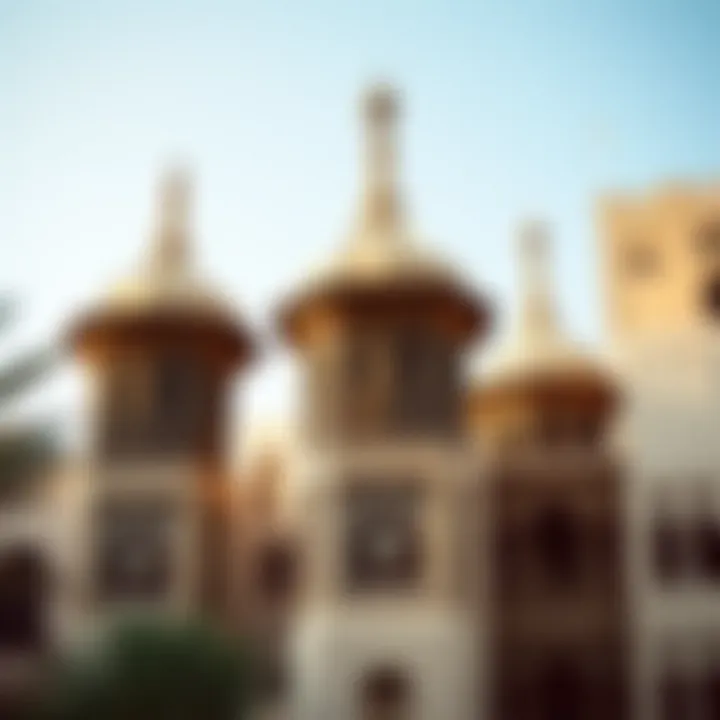
Cultural Institutions in Al Fahidi
The presence of cultural institutions in Al Fahidi serves as a cornerstone of the area’s identity. They carry the essence of Dubai’s historical narrative and provide a stage for the vibrant tapestry of local culture. The institutions not only educate visitors about the rich heritage of the region but also act as vibrant community hubs for both expats and locals. They facilitate a deeper understanding of the Emirati way of life, offering insights into traditions that might otherwise remain obscured in modern Dubai's fast pace.
Dubai Museum
Nestled within the Al Fahidi District, the Dubai Museum stands out as a beacon of historical significance. Housed in what was once the Al Fahidi Fort, the museum is a treasure trove of artifacts and exhibits that chronicle the evolution of Dubai from a humble fishing village to a sprawling urban center.
Visitors can stroll through the atmospheric displays that include dioramas illustrating daily life in ancient times, showcasing everything from traditional pearl diving to the impact of the oil boom. The museum's immersive experience offers profound insights into Dubai's cultural transformations, making it an essential stop for those wanting to grasp the depth of the city's history. Moreover, this institution plays a significant role in preserving local history and encouraging the appreciation of cultural heritage amongst visitors and residents alike.
Sheikh Mohammed Centre for Cultural Understanding
This center embodies the ethos of intercultural understanding and respect. The Sheikh Mohammed Centre for Cultural Understanding offers guided tours, workshops, and even traditional Emirati meals that encapsulate the warmth and hospitality of the local people. Here, tourists can engage in discussions about Emirati customs, the Arabic language, and religion in an open environment.
The center operates on the principle of "Open Doors, Open Minds," actively promoting cultural exchanges. The intimate setting allows for candid conversations, debunking myths and misconceptions about Emirati culture, and providing rich perspectives on what it means to be part of this diverse tapestry.
This initiative not only fosters respect but also enhances social cohesion, bringing together people from all walks of life.
Art Galleries and Local Exhibitions
In Al Fahidi, the world of art thrives alongside the whisper of history. The neighborhood is home to various art galleries showcasing works from both local and international artists. From contemporary pieces to traditional crafts, these galleries serve as a reflection of the region's evolving artistic expressions.
Local exhibitions often highlight the craftsmanship of Emirati artists, celebrating traditional skills like weaving and pottery alongside modern art installations. Events are frequently organized to promote local talent, discussions about artistic practices, and workshops that invite community involvement.
Participating in these vibrant cultural exchanges offers visitors more than just a visual feast; it fosters appreciation for the artistic endeavors that shape identity and expression in a rapidly changing environment.
"Art is the most beautiful of all lies; you can see the truth in it."
Exploring the Souks Nearby
The souks around Al Fahidi Historical Neighborhood represent a vibrant pulse of Dubai's cultural and economic life. These traditional markets are not just a place for trade; they are landmarks that capture the spirit of the emirate. Visitors and locals alike are drawn to these bustling hubs, where the air is laced with the scent of spices, gold, and textiles. Exploring these markets offers a multifaceted experience of shopping, cultural exchange, and an opportunity to connect with Dubai’s deep-rooted heritage.
The Spice Souk
The Spice Souk, often regarded as a sensory overload, is a haven for those who appreciate culinary adventures. This market is a treasure trove of aromatic spices and herbs, reflecting the rich trading history of the region. It is here that one can find everything from saffron to za'atar, alongside a myriad of dried fruits and nuts.
Shopping for spices in the Souk is not just transactional; it is an immersive experience. Vendors often share their knowledge, explaining the uses of various spices and suggesting how they can elevate a dish. This interaction not effectively fosters a deeper appreciation of the local cuisine but also encourages cultural exchanges among different communities.
The Spice Souk embodies the historical trade routes that have shaped Dubai's economy, making it a vital part of the city’s identity.
Gold Souk Dynamics
The Gold Souk stands as a dazzling testament to Dubai's reputation as a global gold trading hub. This marketplace is replete with glittering shops that showcase a stunning array of gold jewelry, from intricate traditional designs to modern chic styles. Notably, the Gold Souk is not merely about luxury purchases; it serves as a cultural barometer reflecting shifting tastes and trends in jewelry design.
One unique aspect of the Gold Souk is the bargaining culture. Haggling is expected, and many buyers relish the thrill of negotiating prices. This practice is rooted in Arabic hospitality and adds an engaging dimension to the shopping experience. Conclusively, the Gold Souk is not only a destination for exquisite jewelry but also a space that promotes economic interaction and cultural understanding.
Textile Souk Offerings
The Textile Souk presents a delightful contrast to the prevailing gold and spice markets, embodying the rich tapestry of Dubai's cultural diversity. As you navigat through narrow lanes adorned with vibrant fabrics, the sheer variety available is astounding. Here, silk, cotton, and traditional Emirati garments come together under one roof, each telling a story through design and material.
Shoppers can find a mix of traditional attire, such as abayas and kaftans, alongside high-quality materials for custom garments. This market is especially popular among expatriates looking to acquire traditional clothing or fabrics that reflect their own cultures. The Textile Souk is not merely a shopping destination; it’s a celebration of the emirate’s multicultural fabric, fostering a sense of community and shared experiences.
Through their distinct character and offerings, the souks surrounding Al Fahidi create a rich milieu reflecting both the historical and contemporary aspects of Dubai. They entice investors seeking unique commercial opportunities while simultaneously encouraging culturally immersive experiences for all who visit.
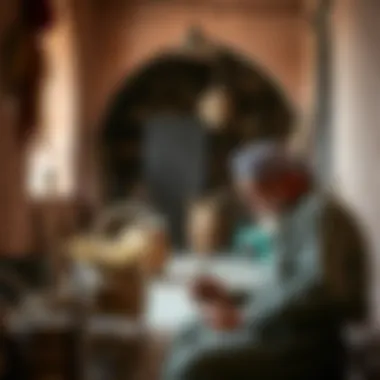

Al Fahidi as a Tourism Hub
Al Fahidi Historical Neighborhood stands out as a focal point for tourists seeking to absorb the cultural essence of Dubai. As visitors journey through its narrow lanes lined with traditional wind towers and charming museums, they uncover layers of history that set Dubai apart from other modern cities. The significance of Al Fahidi goes beyond mere aesthetic appeal; it offers a genuine glimpse into the past, balancing that with a sense of vibrant community. This environment enriches the tourist experience, making it both immersive and enlightening.
Visitor Experience and Activities
The experience of exploring Al Fahidi is akin to stepping back in time. From the moment one enters its cobbled streets, the contrast with the modern skyline of Dubai is palpable. Tourists can engage in various activities that highlight the district's cultural heritage. Visitors might find themselves soaking up the ambiance at the Dubai Museum, housed in the oldest standing building in Dubai, Al Fahidi Fort. The exhibits provide a comprehensive overview of the UAE's history, traditions, and evolution.
Beyond museums, Al Fahidi also fosters a lively arts scene. Numerous art galleries showcase local talent, and studios often invite guests to participate in workshops. The smell of spices wafts through the air as tourists wander into vibrant shops, each offering a unique blend of goods - from handmade crafts to exquisite textiles. Options abound for culinary experiences as well, from local eateries serving traditional Emirati dishes to modern cafés catering to international tastes.
Of particular note is the chance for tourists to experience cultural interactions directly with local artisans and shopkeepers, whose stories and crafts weave the tapestry of their neighborhood. This direct engagement elevates a simple visit into a deeper understanding of Emirati culture, making it an enriching experience well worth the effort.
Annual Cultural Events
An essential component of Al Fahidi's appeal as a tourism hub lies in its celebration of annual cultural events. Each year, the neighborhood plays host to several festivals that enrich the local community and allure visitors from all around the globe. For instance, the Dubai Art Season transforms Al Fahidi into a haven for art enthusiasts. During this period, visitors can attend art exhibitions, performances, and various programs that showcase both local and international artists.
The Dubai Culture and Arts Authority often highlights local traditions during these events, bridging the gap between the old and the new.
Moreover, the Sheikh Mohammed Centre for Cultural Understanding holds regular events that promote dialogue between expatriates and locals, fostering mutual respect and understanding. These cultural exchanges often include cuisine tastings, traditional dance shows, and guided heritage tours, making it an excellent opportunity for tourists to delve deeper into Emirati customs.
Every December, Al Fahidi also hosts the UAE National Day celebrations, where songs, dances, and traditional performances echo through the streets. With each festivity, the ambiance of Al Fahidi morphs into a lively carnival, inviting tourists to partake in genuine celebrations that pay homage to the rich culture of the Emirates.
In summary, Al Fahidi proves itself not just as a historic space, but as a vivid tourism hub where visitors can actively engage with and appreciate the Emirati heritage. The combined effect of educational experiences, artistic expression, and cultural events creates a compelling narrative that resonates with tourists, making the neighborhood both a destination and a profound exploration of a rich cultural tapestry.
For more information about cultural events in Dubai, visit Dubai Culture.
For details on local galleries and their exhibitions, check Art Dubai.
Challenges in Preserving Heritage
The Al Fahidi Historical Neighborhood, a jewel in the heart of Dubai, undoubtedly embodies the rich cultural heritage that this vibrant city aims to sustain. Despite its historical significance and aesthetic value, this neighborhood faces several challenges that threaten its preservation. Understanding these challenges not only highlights the fragility of such treasures but also emphasizes the importance of deliberate efforts to protect and promote them.
Urban Development Pressures
Urban development stands as one of the most pressing challenges in preserving the heritage of Al Fahidi. With Dubai's rapid growth and its incessant lust for modernization, the neighborhood often finds itself on a tightrope, teetering between development and conservation. Investors and developers are eyeing plots in Al Fahidi, driven by the allure of high returns. Yet, as construction cranes dot the skyline, they risk overshadowing the very essence of what makes this area unique.
- Increased Property Values: The surge in interest from investors can spike property values in the area. As buyers explore potential investments, higher prices may push local residents out, diluting the cultural fabric that binds this community.
- Architectural Changes: The demand for modern amenities often leads to alterations or demolitions of traditional structures. Ornate wind towers may be replaced by faceless high-rises, stripping the neighborhood of its rich architectural narrative.
"To preserve history, we must not sacrifice it for the sake of progress."
This trap of modern development cannot be ignored. Stakeholders must recognize that protecting heritage is not at odds with modern investment. Instead, there can be smart development taking place in a manner that respects and enhances the historical context.
Balancing Modernity with Tradition
Striking a balance between modernity and tradition is a delicate dance that requires artful consideration. The growth of tourism through visits to Al Fahidi can be beneficial, but if not managed carefully, it can lead to a superficial experience that fails to resonate with the area's authenticity.
- Cultural Events and Heritage Experiences: Efforts to marry contemporary experiences with traditional storytelling can breathe life into Al Fahidi while maintaining its soul. Workshops that teach traditional crafts or guided tours that emphasize historical narratives can enrich visitors’ understanding.
- Community Involvement: Engaging local residents in the decision-making process fosters a sense of ownership over their heritage. Their input can lead to initiatives that respect traditional values while still catering to modern needs. Investors can leverage this by incorporating community feedback, resulting in sustainable growth that honors the past.
The art of harmonizing tradition with contemporary expectations is not just a challenge; it’s a necessity. When managed adeptly, it opens paths for innovation while keeping heritage at the forefront. As the neighborhood navigates these challenges, its relevance can not only be maintained but elevated, reminding everyone of its integral place in Dubai’s rich historical tapestry.
Investment Potential in Al Fahidi
The phrase "location, location, location" rings true in real estate, and Al Fahidi Historical Neighborhood is no exception. With its rich cultural backdrop and architectural charm, this area presents a unique investment opportunity. Investing in Al Fahidi means diving into a blend of historical essence and modern conveniences, an attractive proposition for discerning investors and expatriates.
One of the distinct advantages of Al Fahidi lies in its potential for appreciation. As Dubai continues to evolve, areas rich in culture are becoming increasingly desirable not just for tourists but also for those wishing to plant roots in a vibrant community. The neighborhood's proximity to the Dubai Creek and bustling souks enhances its appeal, offering both tourists and locals a delightful combination of accessibility and atmosphere.
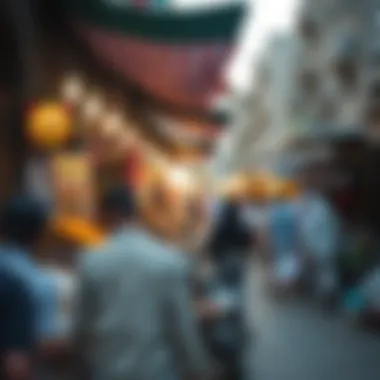
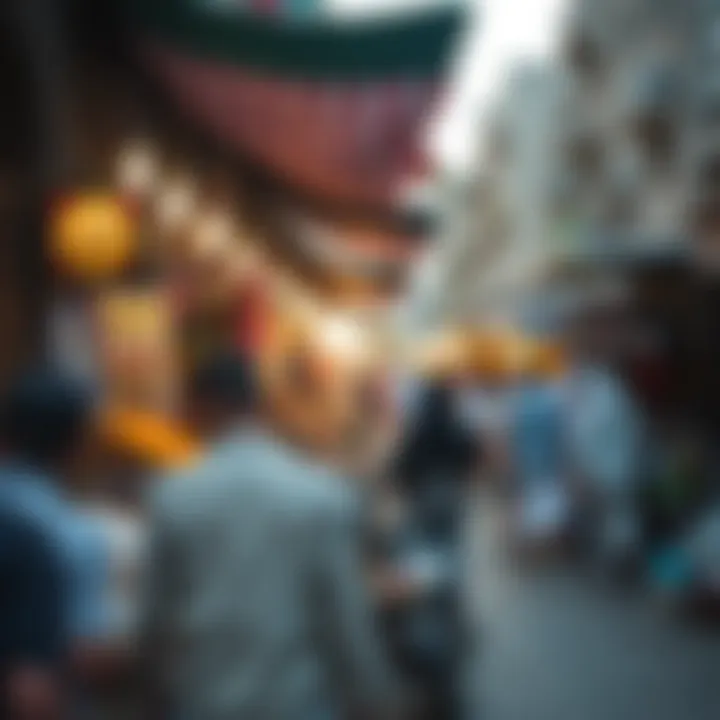
Real Estate Opportunities
Investors eager to capitalize on real estate opportunities in Al Fahidi will find various options. From restored traditional homes to newly constructed luxury apartments that pay homage to the historical aesthetic, the market is diverse. Here are some enticing prospects:
- Renovation Projects: Many old buildings are available for restoration, allowing investors to blend modern amenities with traditional designs, making them appealing to buyers seeking authenticity.
- Commercial Spaces: With the neighborhood's foot traffic and tourist attraction, businesses catering to visitors have significant potential for profitability, including cafes, artisan shops, and galleries.
- Residential Units: New housing developments aim to provide families and young professionals unique living environments infused with culture, which could attract long-term tenants or future buyers.
Market Trends and Valuation Insights
The real estate market in Al Fahidi reflects broader trends within Dubai. Prices have seen fluctuations linked to the global economy, but the long-term outlook remains promising. Key points include:
- Increasing Interest Rates: With rising interest rates in Dubai, investors must evaluate the cost of financing against potential returns. However, the anticipated growth in value might offset these increases for long-term holdings.
- Shift Towards Heritage Sites: As many urbanites seek living spaces that offer a narrative or history, neighborhoods like Al Fahidi are becoming hot tickets. Buyers are not merely acquiring property; they are investing in a lifestyle.
- Performance Metrics: Rental yields for properties in Al Fahidi typically hover around 6-8%, which is competitive in Dubai's overall market. Investors should keep a keen eye on how these figures evolve, as demand for historical neighborhoods could push values higher.
"Investing in culturally rich neighborhoods like Al Fahidi connects individuals to the spirit of the city while promising financial upside."
Be it for personal comfort or strategic investment, Al Fahidi beckons with its historic allure and modern potential, standing as a testament to the duality of the past and future. As the landscape in Dubai shifts, being well-informed about opportunities in Al Fahidi could turn out to be a wise choice.
Community and Social Aspects
In Al Fahidi Historical Neighborhood, community and social dimensions are intricately woven into the fabric of daily life. Exploring these aspects offers a glimpse into how the neighborhood sustains its cultural relevance while adapting to contemporary times. These dimensions not just enrich the texture of the neighborhood but also signal potential dynamics for interested investors, buyers, and developers aiming to engage with this unique locale.
Local Residents and Their Stories
The residents of Al Fahidi carry a legacy that is deeply intertwined with the history of Dubai itself. Each home, originally a bastion of family life, has stories echoing through generations. From weaving traditional textiles to practicing ancient crafts, locals continue their practices while embracing modernity. The tales of a grandmother who hand-embroidered garments for weddings or a father who tenderly restores the architecture of his ancestors breathe life into the surroundings.
One such resident, an elderly man known as Ahmed, recounts fond memories of his childhood spent playing in narrow alleyways, which today serve as canvas for artists. His stories are not merely nostalgia; they depict resilience and adaptability. Residents like him are key figures in community gatherings, enabling cultural exchanges and fostering a bond among neighbors. This sense of belonging is crucial for potential investors: understanding the social fabric can lead to informed decisions in real estate, carving paths that enhance community welfare.
Cultural Exchanges and Interactions
Al Fahidi does not just preserve its own culture; it acts as a vibrant hub for cultural exchange. This is particularly evident during festivals, where the blending of Emirati traditions with customs from expatriate communities creates a rich tapestry of experiences. Take for instance, the annual Dubai Art Season, where local artists showcase their work alongside international creatives. These interactions cultivate an environment of learning and sharing, which is vital for anyone looking at potential investments in cultural initiatives or hospitality ventures.
Visitors are often welcomed into this mix of cultures, encouraging them to engage in workshops that teach Arabic calligraphy or traditional cooking. Such activities not only promote community integration but also heighten the interest of expatriates seeking authentic experiences. In fact, studies show that neighborhoods fostering diverse interactions see a significant increase in property value, thus proving the importance of vibrant community dynamics to potential buyers and developers.
In a city that is always looking ahead, the past has much to teach us. Al Fahidi exemplifies the balance of tradition and innovation.
The social framework in Al Fahidi goes beyond mere interaction; it builds a legacy that captivates observers and participants alike. Recognizing this can shape the future direction of any project, whether it aims to honor the past or innovate for the future. Thus, understanding the community and its social aspects not only enriches the experience of living and visiting but also lays a crucial foundation for sustainable development.
Future Directions for Al Fahidi
The Al Fahidi Historical Neighborhood stands at a crossroads of past and future, showcasing the significance of preserving Dubai's heritage while embracing contemporary developments. As Dubai continues to evolve as a global hub, it's pivotal to correlate heritage with modern needs. Those interested in investment or real estate opportunities here must understand the importance of these future directions. Evolving from a charming locality steeped in history, Al Fahidi is set to further delineate its role as a sustainable, vibrant neighborhood attractive to both residents and visitors.
Sustainable Development Initiatives
In recent years, sustainable development efforts have taken root in Al Fahidi, aiming to blend the old with the new while remaining environmentally conscious. This integration not only enhances the aesthetic appeal of the neighborhood but also promotes eco-friendly practices within the cultural context of the area.
The following initiatives have been established:
- Green Building Practices: Many renovations adhere to green building guidelines. Architects use energy-efficient materials and designs that minimize environmental impacts.
- Public Transport Enhancements: With the introduction of new transport links, including the Dubai Metro, accessibility is improving without compromising the neighborhood's historical integrity.
- Community Green Spaces: Small parks and green areas are being developed, encouraging local gatherings and enhancing the quality of life for residents.
These efforts ensure that Al Fahidi remains not just a relic of the past but a lively part of modern Dubai, drawing in tourists and residents who appreciate both heritage and sustainability.
Vision for Historical Preservation
When we look to the future of Al Fahidi, the vision for historical preservation looms large. Protection and restoration efforts are essential for maintaining the area's unique character against the tide of urbanization. This vision encompasses multiple aspects:
- Adaptive Reuse of Buildings: Rather than tearing down old structures, there is a movement towards renovating them for new uses. This approach preserves cultural identity while accommodating modern functionalities.
- Education and Cultural Programs: Increasing public awareness about the significance of Al Fahidi is crucial. Through workshops, exhibitions, and guided tours, the community is invited to engage with their heritage actively.
- Collaboration with Local Authorities: Working closely with governmental and non-governmental organizations ensures that preservation efforts align with broader cultural and economic goals.
“In a fast-paced, ever-changing world, keeping roots while growing forward is the key.”
Such a commitment to preserving history not only safeguards Al Fahidi's architectural treasures but also strengthens community bonds. As investors eye opportunities in the area, understanding these preservation initiatives becomes critical for making informed decisions. With a shared vision, stakeholders can foster a neighborhood that honors its past while paving the way for a promising future.
